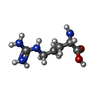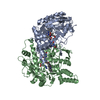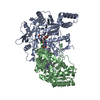+Search query
-Structure paper
| Title | Mapping interactions of calmodulin and neuronal NO synthase by crosslinking and mass spectrometry. |
|---|---|
| Journal, issue, pages | J Biol Chem, Vol. 300, Issue 1, Page 105464, Year 2024 |
| Publish date | Nov 16, 2023 |
 Authors Authors | Dana Felker / Kanghyun Lee / Thomas H Pospiech / Yoshihiro Morishima / Haoming Zhang / Miranda Lau / Daniel R Southworth / Yoichi Osawa /  |
| PubMed Abstract | Neuronal nitric oxide synthase (nNOS) is a homodimeric cytochrome P450-like enzyme that catalyzes the conversion of L-arginine to nitric oxide in the presence of NADPH and molecular oxygen. The ...Neuronal nitric oxide synthase (nNOS) is a homodimeric cytochrome P450-like enzyme that catalyzes the conversion of L-arginine to nitric oxide in the presence of NADPH and molecular oxygen. The binding of calmodulin (CaM) to a linker region between the FAD/FMN-containing reductase domain, and the heme-containing oxygenase domain is needed for electron transfer reactions, reduction of the heme, and NO synthesis. Due to the dynamic nature of the reductase domain and low resolution of available full-length structures, the exact conformation of the CaM-bound active complex during heme reduction is still unresolved. Interestingly, hydrogen-deuterium exchange and mass spectrometry studies revealed interactions of the FMN domain and CaM with the oxygenase domain for iNOS, but not nNOS. This finding prompted us to utilize covalent crosslinking and mass spectrometry to clarify interactions of CaM with nNOS. Specifically, MS-cleavable bifunctional crosslinker disuccinimidyl dibutyric urea was used to identify thirteen unique crosslinks between CaM and nNOS as well as 61 crosslinks within the nNOS. The crosslinks provided evidence for CaM interaction with the oxygenase and reductase domain residues as well as interactions of the FMN domain with the oxygenase dimer. Cryo-EM studies, which gave a high-resolution model of the oxygenase domain, along with crosslink-guided docking provided a model of nNOS that brings the FMN within 15 Å of the heme in support for a more compact conformation than previously observed. These studies also point to the utility of covalent crosslinking and mass spectrometry in capturing transient dynamic conformations that may not be captured by hydrogen-deuterium exchange and mass spectrometry experiments. |
 External links External links |  J Biol Chem / J Biol Chem /  PubMed:37979917 / PubMed:37979917 /  PubMed Central PubMed Central |
| Methods | EM (single particle) |
| Resolution | 2.7 - 3.14 Å |
| Structure data | EMDB-40969, PDB-8t1j: EMDB-40970, PDB-8t1k: |
| Chemicals |  ChemComp-ZN:  ChemComp-ARG:  ChemComp-H4B:  ChemComp-HEM: |
| Source |
|
 Keywords Keywords | CYTOSOLIC PROTEIN / Calmodulin / Complex |
 Movie
Movie Controller
Controller Structure viewers
Structure viewers About Yorodumi Papers
About Yorodumi Papers








